Text copyright Canbooks Pictures copyright held by their respective owners

Picture by Marion Kaplan Used with permission
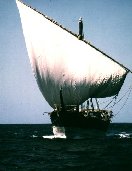
Picture by Marion Kaplan Used with permission
For many centuries, boats that sailed on the Indian Ocean were called dhows. While there were many different types of dhows, almost all of them used a triangular or lateen sail arrangement. This made them markedly different than the ships that evolved on the Mediterranean. These ships had a characteristic square sail. The dhow was also markedly different than the ships that sailed on the China Sea. These ships were known as junks.
Unfortunately, there is almost no pictorial evidence of early dhows. Most of our knowledge of the dhow’s early construction comes to us from the records of Greek and early Roman historians. Added to this, we can compare some similar hull constructions used in the later Roman period, after they had opportunity to learn from the Arab sailors. Along with this we can examine early shipwrecks, and lastly we can learn from modern day construction of dhows. It seems that dhow making is considered an art, and this art has been passed down from one generation to another, preserving, at least in part, the dhow’s basic design and use. (Some modern dhow makers now nail their hulls together, and many are now making a square stern rather than a double-ended vessel.) By taking all of these into consideration, we can get an excellent idea of how the ancient dhow was constructed and what its sailing abilities were.
Despite their historical attachment to Arab traders, dhows are essentially an Indian boat, with much of the wood for their construction coming from the forests of India.
In Europe, boats names are based on the type of sail rigging the boat has. Thus, it is typical for Europeans to label all Arab boats as dhows. In the Middle East however, boats are classified according the shape of their hull. Thus, dhows with square sterns have the classifications: gaghalah, ganja, sanbuuq, jihaazi. The square stern is basically a product of European influence, since Portuguese and other boats visited the Arab gulf since the sixteenth century.
Older type vessels are now called buum, zaaruuq, badan, etc., and still have the double-ended hulls that come to a point at both the bow and the stern.
The generic word for ship in Arab is markab and safiinah. Fulk is used in the Quran. The word daw is a Swahili name, and not used by the Arabs, although it was popularized by English writers in the incorrect form of dhow.
The dhow was known for two distinctive features. First of all, it’s triangular or lateen sail, and secondly, for it’s stitched construction. Stitched boats were made by sewing the hull boards together with fibers, cords or thongs.
The idea of a boat made up of planks sewn together seems strange. Actually, it is a type that has been in wide use in many parts of the world and in some places still is. In the Indian Ocean, it dominated the waters right up to the fifteenth century, when the arrival of the Portuguese opened the area to European methods. A Greek sea captain or merchant who wrote in the first century AD reports the use of small sewn boats off Zanzibar and off the southern coast of Arabia. Marco Polo saw sewn boats at Hormuz at the entrance to the Persian Gulf. He took a dim view of them: “they were twine and with it stitch the planks of the ship together. It keeps well and is not corroded by sea-water but it will not stand well in a storm.” (Marco Polo, Book I, ch xviii, translated by H. Yule, 3rd edition, London, 1903, I, p.108)
Later travelers reported seeing large sewn boats of 40 and 60 tons’ burden and versions of fair size were still plying the waters of East Africa and around Sri Lanka in the early decades of the twentieth century.
“The earliest surviving example of a sewn boat, as we shall see, was found beside the great pyramid of Giza, but it is unquestionably a descendant of ancestors that go back to Egypt’s primitive times. Sewn boats are mentioned by ancient Roman writers, from tragic poets to the compiler of Rome’s standard encyclopedia, in ways betraying their conviction that such boats belonged to the distant past, the days of the Trojan War, of Aeneas and Odysseus. They were surely right in connecting sewn boats with an early age. They were wrong only in assuming that it had not lived on: marine archeologists have found remains of sewn boats that date from the sixth century BC on into the Roman Imperial age. By the fashioning of a hull by sewing planks together, despite its early appearance and continued existence, remained a byway. As the following chapters will reveal, the mainstream of boat building followed a different channel.” (Ships and Seamanship in The Ancient World, Lionel Casson, Princeton University Press, 1971)
History of the Dhow
According to Hourani, fully stitched construction was observed by medieval writers in the Red Sea, along the east African coast, in Oman, along the Malabar and Coromandel Coasts of India and in the Maldives and Laccadive Islands.
Deloche summarizes the characteristics of pre-European influence, ocean going Indian ships based on pictorial evidence. They were double-ended craft. Prior to the eleventh century AD, the stern was raked, but after that time, a long projecting bow became the predominate characteristic. Hull planks were flush-laid and stitched with the stitches crossed and penetrating right through the planks.
Procopius, writing in the sixth century AD, tells us that ships used in the Indian Seas ‘are not covered with pitch or any substance, and the planks are fastened together, no with nails but with cords.’ (Ray, 1994, pg 173)
Some illustrations of stitching can be found in Sanchi sculptures of the second century BC, and paintings accompanying al-Harari’s Maqamat of AD 1237. The thirteenth century AD account of Marco Polo is less than complimentary: “The vessels built at Hormuz are the worst kind, aand dangerous for navigation, exposing the merchants and others who make use of them to great hazards.”

A possible reconstruction of early ocean-going dhows. Their main characteristics were sewn double ended construction, steering oars at the stern and a lateen rigged sail.

A possible reconstruction of a later dhow with stern rudders and a rope system of steering.
Contemporary records prove without a doubt that during the third millennium BC, Babylon carried on extensive overseas trade through the Persian Gulf southward to the east African coast and eastward to India. Hardly anything is known about the vessels used on these ambitious runs other than that they were very small; the largest mentioned has a capacity of some 28 tons. (Ships and Seamanship in The Ancient World, Lionel Casson Princeton University Press, 1971, Page 23)
A ‘seagoing boat’ of 300 gur is mentioned in a document of 2000 BC; see A. Oppenheim “The Seafaring Merchants of Ur.” (Journal of the American Oriental Society 74, 1954, 6-17, especially 8 note 8. For the size of the gur, see Appendix 1, note 5)
Masts and sails
In early times the masts and yards were probably made of coconut wood and teak, although a number of woods were used in later construction. It is thought that originally sails were woven from coconut of palm leaves, and that eventually cotton cloth became the favorite for merchants on long voyages. Cotton cloth was manufactured in India. Two main sails were carried, one for night and bad weather, and the other for day and fair weather. Sails on a dhow could not be reefed.
The lateen sail used by Arabs stops short of being completely triangular. Their sails retained a luff at the fore part in proportion to the leech of roughly 1-6 in the mainsail. The retention of this luff added a much greater area of sail to be hoisted than would a completely triangular design. During the Byzantine era the Lateen sail completed its evolution into a triangle, and this idea spread from Byzantium to the rest of Europe, where it developed into the varieties of mizzen sails which later gave European sailing ships so much flexibility. From there it was eventually developed in the west into all the types of fore-and-aft rig known to yachtsmen today, a form superior still to the lateen for sailing close to the wind.
It is assumed by some that the lateen sail developed on the Red Sea, and spread from there to the Mediterranean Sea and Persian Gulf. There is some evidence that a fore-and-aft lateen rig arrived in the Aegean Sea from the 2nd century onward, and in the Persian Gulf around this time.
The masts and rigging of the dhow was similar in all types of dhows, with added rigging in larger vessels. Masts were secured at the base by being slotted into a mast step, which fit over the floor timbers. The rigging of a typical dhow can be seen in the diagram below. Cables were often made of coir.
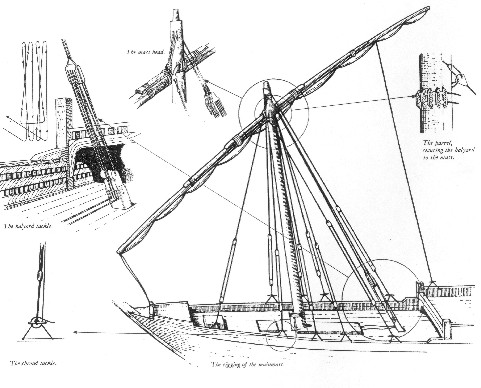
Sails
The lateen sail on the dhow looks triangular to the casual observer, but in fact it is quadrilateral and is correctly termed a settee sail. Was sail is made of several cloths, sewn parallel to luff and leech. Different types of sail were made according to the requirements: a sail wanted for reaching would be made less flat and with a fuller luff than a sail wanted for beating.
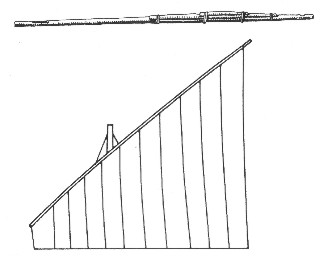
The lateen yard was normally very long in proportion to the mast and hull, and was sometimes made of more than one piece of timber. In this case, it was fitted with a strengthening piece, along the middle. Two holes were them made so that the halyard type could be secured to prevent it from slipping along the yard. On a yard of very great length a second strengthening piece would be fitted along the middle of the first.
Modern Dhows
There were a number of different types of dhows that evolved. Some of the types common during the last two hundred years are illustrated below.
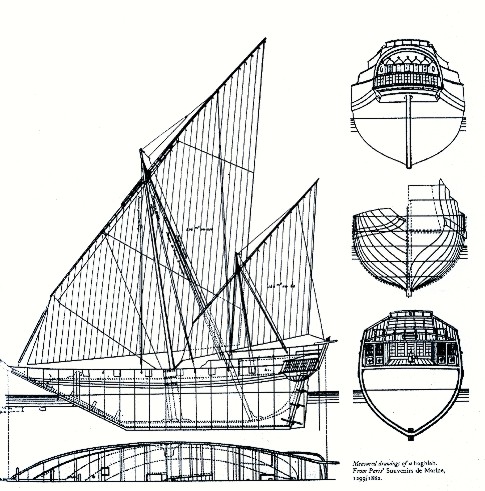
Above: A baghlah with a modern square stern. Illustration taken from Paris' Souvenirs de Marine, 1882.
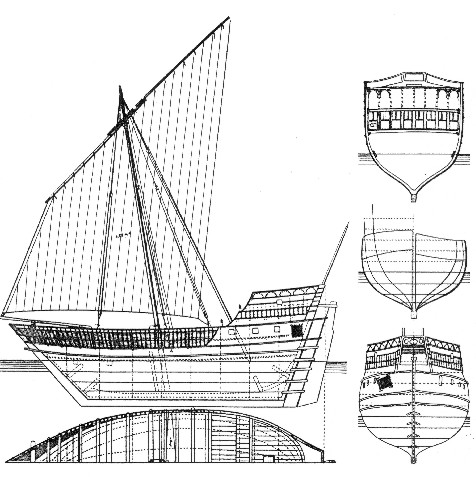
Above: a Cuch dungiyah. Illustration taken from Paris' Souvenirs de Marine, 1882.

Above: a sewn fishing badan, as seen in the 1830's.
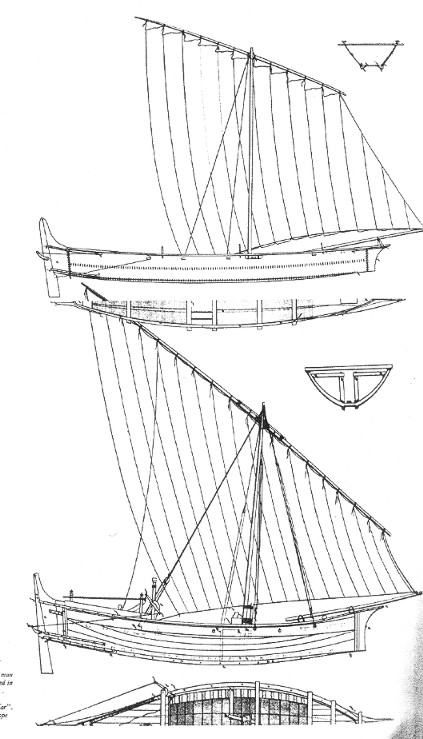
Above: A cargo badan seen in the 1830's. Drawing first published in Paris' Essai sur la construction.' Note the double keel pieces and the rope system of steering on each of the two above dhows.

Above: A baggarah with a rope steering gear in the 1830's from Paris' Essai sur la construction. The hull of this small boat is very similar to a battil, but the stern-piece is continued in a straight line instead of the club like shape of the battil, but lacks protection despite it's high stern post. This vessel is also known today as a shahuf, and is often used as a fishing vessel along the coasts of the Persian Gulf, Oman and Yemen.
Summary
Dhow shipbuilding is a very ancient trade. In various places around the world, ship building techniques and styles developed until they were successful. Once they reached this stage, schools of shipbuilding, with their various skills and knowledge solidified certain styles of boats. These styles changed very slowly over the centuries as ship building techniques were often closely guarded secrets. Ship builders took special pride in their particular style of building.
Thus, three styles of ships developed in the ancient world. On the Mediterranean, triremes and trade boats shared similar styles, with small square sails, and outboard steering oars. On the Indian Ocean, dhows, with their triangular sails and stitched hull design dominated the waters. On the China seas, Chinese junks, with their tall forecastles, multiple masts, and unique sail rigging and sternpost rudder existed for centuries.
Each of these seas was separated from the other, some by landmasses, and some by dangerous striates and massive cultural differences. Bridging the gaps between these civilizations were other smaller civilizations that daringly took goods and knowledge from one sphere to the other. In Arabia, the Nabataeans played this role. In Asia, sailors with their lashed-lug ships seemed to have played this role.
It was only when ship builders saw a proven improvement that they would adapt it into their own design. Thus, ship design changed very slowly over time, allowing us to fill in the gaps in shipbuilding knowledge, but looking at previous designs and later designs. Changes in shipbuilding technique also point to nautical contacts between these three great shipbuilding spheres. Added to this, it must be accepted that many if not most dhows were built in India, and sold to Arab traders.
Dhows and the Nabataeans
As mentioned in my paper Who were the Ancient Arab Traders, the Nabataeans were known as seamen, and at various points in history totally dominated the shipping that was taking place on the Red Sea. While they originally obtained their boats by piracy, they must have either bought boats from India, or constructed or remodeled them themselves. It is interesting to note that some nautical historians point to the Red Sea as the probably place where the lateen sail was first developed. Perhaps the Nabataeans played a role in its development, since the lateen sail would have made it possible for them to bring the frankincense harvest up the Red Sea to their port at Leuke Kome. (See Sailing and Navigation) Whatever the case, dhows were the preferred boat for transporting cargoes on the Indian Ocean, and they dominated this scene for almost two thousand years.
Bibliography
Casson, Lionel, Ships and Seafaring in Ancient Times, British Museum Press, 1994, London
Flecker, Michael, A ninth-century AD Arab or Indian shipwreck in Indonesia: first evidence for direct trade with China. World Archaeology, Volume 32(3): 335-354 Shipwrecks, Taylor & Francis Ltd, 2001
Griffith, T., Marco Polo: The Travels, Wordsworth, London, 1997
Hourani, G. F., Arab Seafaring in the Indian Ocean in Ancient and Early Medieval Times, Princeton University Press, Princeton, 1995
Manguim, P. Y., Southeast Asian shipping in the Indian Ocean during the first millennium A.D. In Tradition and Archaeology, (eds H. P. Ray and J.F. Salles), State Publishers, New Delhi, 1996, pp 181-198
Paris’ Essai sur la construction, 1930
Paris’ Souvenirs de Marine, 1882.
Ray, H. P. and Salles J. F., _Tradition and Archaeology: Early Maritime Contacts in the Indian Oce_an, State Publishers, New Delhi, 1996
Tibbetts, G. R., Arab Navigation in the Indian Ocean before the Coming of the Portuguese, London: Royal Asiatic Society of Great Britain and Ireland, 1981
Vosmer, T., 1997, Indigenous fishing craft of Oman, International Journal of Nautical Archaeology, 26(3): 217-235
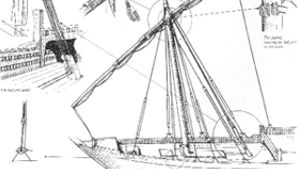
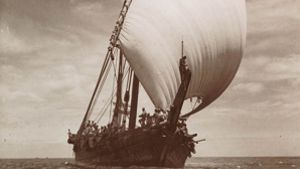
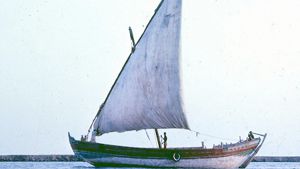
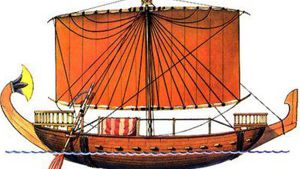

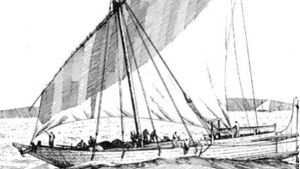
Page Discussion
Membership is required to comment. Membership is free of charge and available to everyone over the age of 16. Just click SignUp, or make a comment below. You will need a user name and a password. The system will automatically send a code to your email address. It should arrive in a few minutes. Enter the code, and you are finished.
Members who post adverts or use inappropriate language or make disrespectful comments will have their membership removed and be barred from the site. By becoming a member you agree to our Terms of Use and our Privacy, Cookies & Ad Policies. Remember that we will never, under any circumstances, sell or give your email address or private information to anyone unless required by law. Please keep your comments on topic. Thanks!